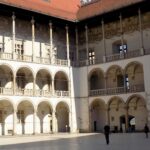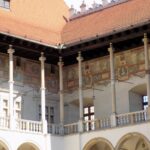Last day in Poland – I am really sad. Although I knew that this vacation would come to an end, I really feel like I need to explore these amazing places more! But sadly, that will not be, so we must explore today! We decide to make a real visit to the Castle which we find on Wawel Hill.
The Wawel Castle is a castle residency located in central Kraków, Poland. Built at the behest of King Casimir III the Great,[2] it consists of a number of structures situated around the Italian-styled main courtyard. The castle, being one of the largest in Poland, represents nearly all European architectural styles of medieval, renaissance and baroque periods. The Wawel Royal Castle and the Wawel Hill constitute the most historically and culturally significant site in the country. In 1978 it was declared a UNESCO World Heritage Site as part of the Historic Centre of Kraków.
For centuries the residence of the kings of Poland and the symbol of Polish statehood, the Castle is now one of the country’s premier art museums. Established in 1930, the museum encompasses ten curatorial departments responsible for collections of paintings, including an important collection of Italian Renaissance paintings, prints, sculpture, textiles, among them the Sigismund II Augustus tapestry collection, goldsmith’s work, arms and armor, ceramics, Meissen porcelain, and period furniture. The museum’s holdings in oriental art include the largest collection of Ottoman tents in Europe. With seven specialized conservation studios, the museum is also an important center for the conservation of works of art.
Needless to say, as this is a central theme of our adventure, we walked. The castle and grounds sit on a hill, so we are walking up hill (we did a lot of that too). Wawel Hill is 25 meters above the Vistula River. This is a view of the river from the castle wall.
This is a view of the river from the castle wall.
It was once surrounded by the rive and swamps so it was a safe place, and easy to defend. There is evidence that this site has been used by city defenders as early as the 9th century. In 1000 A.D., Boleslaus the Brave began construction of the Cathedral. At the turn of the 11th century a Romanesque castle was built and it survived until the 14th century. King Ladislas the Short and King Casimir the Great, Queen Jadwiga and Ladislas Jagiello enlarged and further developed the castle. The castle has an extensive history, fires, invading hordes of armies, and more construction. The Germans used the Castle during the second world war and hung a swastika from the Thieves’ Tower.
The back of the Thieves tower (Left). You can see the different levels of construction, this photo is of some of the persons who contributed over the ages to the construction efforts on the castle. It is a large structure, multiple buildings including a treasury, and armory, the Cathedral, The Royal Residence, and multiple service and military areas.
over the ages to the construction efforts on the castle. It is a large structure, multiple buildings including a treasury, and armory, the Cathedral, The Royal Residence, and multiple service and military areas.
Here you can see a view of the open (huge) courtyard surrounded by multiple services for the castle. The upper corner shot is of the Royal Residence (we did not visit) but we did visit the treasury and armory. I have one photo, before they informed me that photos were not permitted,

We then visited the Wawal Cathedral, Beautiful, awe inspiring (as I imagine they were intended to) we saw a lot of dead kings and queens – visited the crypt, lots of dead people there as well. The patron saints of the cathedral are St. Wenceslas and St. Stanislaus. In the center of the cathedral is a shrine to St. Stanislaus, who was a Bishop and martyr. The story goes that in 1079, King Boleslaus The Bold argued with the Bishop and ordered him killed. They had a conflict and the verdict was that he (the Bishop) was to have his limbs severed from his body. According to the legend, the King killed the Bishop himself and had his body cut into pieces, but the body grew into one in the 13th century. Stanislaus was canonized in 1253 and his grave became a destination of pilgrims praying for miracles in their lives. The legend also contains a prophecy that says that no one with the name Stanislaus could be a successful king of Poland. To date that prophecy has proven true as two kings with the name Stanislaus (so if you know of the prophecy why would you name your baby Stanislaus?) were forced to resign from the throne.

Once upon a time a dragon lived beneath the castle. We had the opportunity to visit the Dragon’s Lair – and amazingly, more stairs 🙂 – but it was a fun way to end the visit to the Castle.
Occasionally, the dragon still breathes fire we got to see it, but I didn’t get photos. The weird looking picture in the bottom right is inside the Lair.
So we leave the castle, I wish I had been able to get more pictures, maybe William will post some of his (hint, hint), but to see more I suppose you will just have to do what I did and visit Krakow – a visit I highly recommend – it is a beautiful place, and it has an amazing history. I think I will go back and read James Michener’s Poland, which, while a novel has a whole lot of history included. Poland has a really interesting history both ancient and current. As our guide reminded us, Poland was behind the Iron Curtain until 1989, and still had Soviet rule until 1991. I have to encourage my readers to learn more about Hungary and Poland – as I will be doing this summer. I would love to go back and repeat this trip, there is so much more to see.









